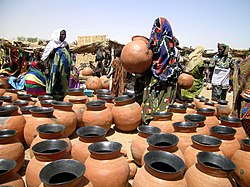Gorom-Gorom | |
|---|---|
 The Gorom-Gorom market | |
| Coordinates: 14°27′N0°14′W / 14.450°N 0.233°W | |
| Country | |
| Region | Sahel Region |
| Province | Oudalan Province |
| Department | Gorom-Gorom Department |
| Population (2019) [1] | |
• Total | 9,752 |
| Time zone | UTC+0 (GMT) |
Gorom-Gorom is a town in northern Burkina Faso. It is the capital of the Gorom-Gorom Department and Oudalan Province, in the Sahel Region. Gorom-Gorom is known for its weekly market, which is the largest in the country and attracts merchants from across the region.
Contents
The 2019 census recorded 9,752 people in Gorom-Gorom, many of whom were nomads from the Tuareg, Fulani, or Songhai ethnic groups. The town and area around it also hosts thousands of internally displaced persons who fled the violence of the Islamist insurgency in Burkina Faso.

